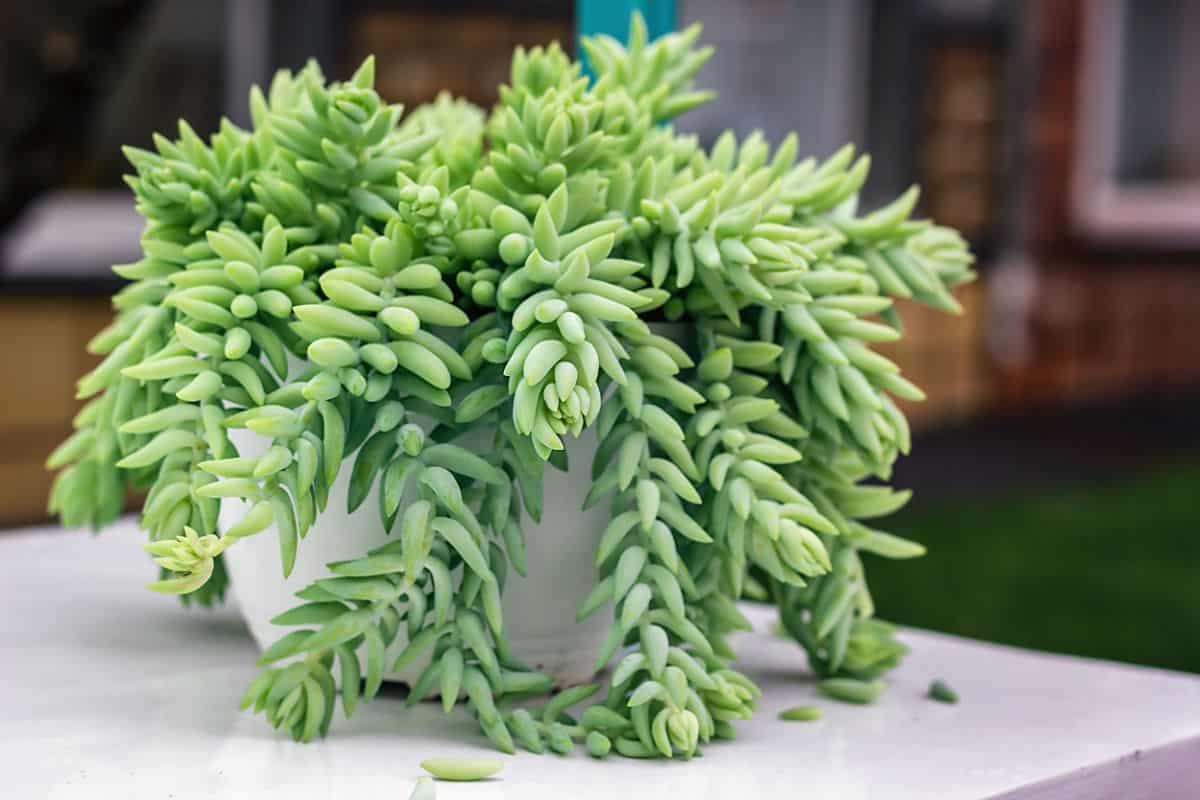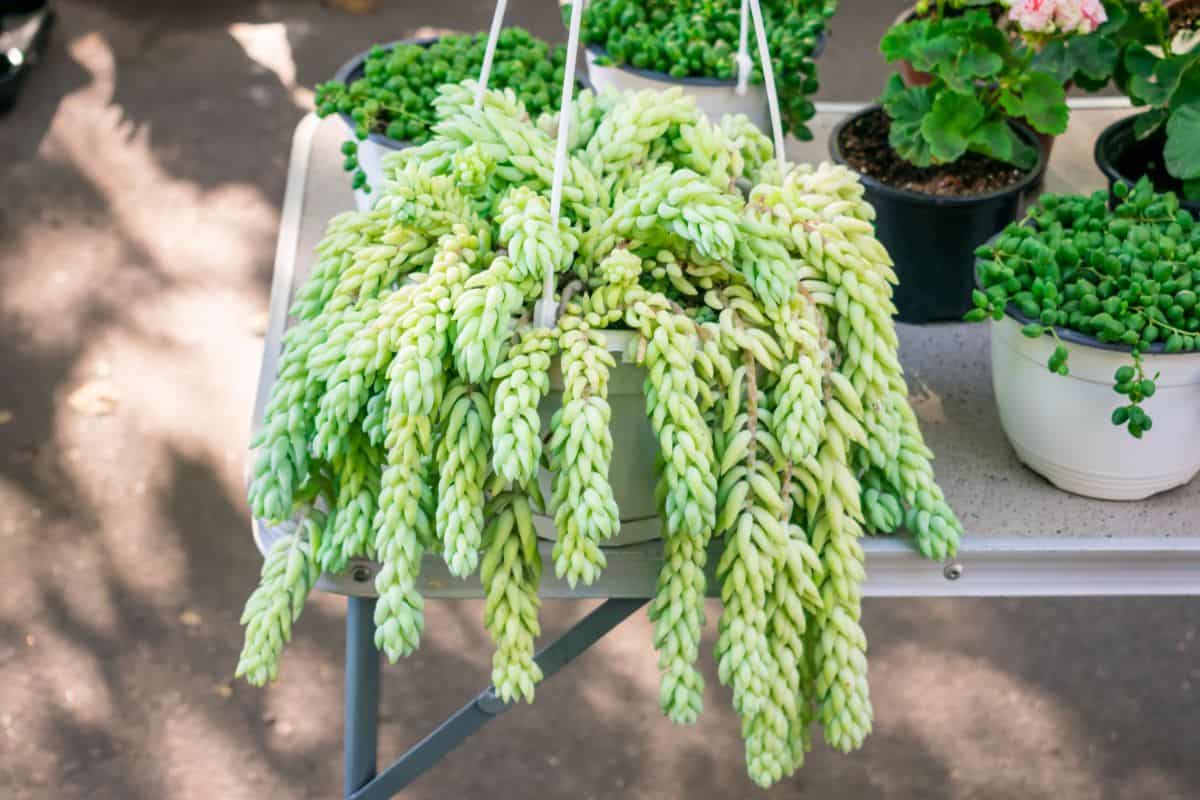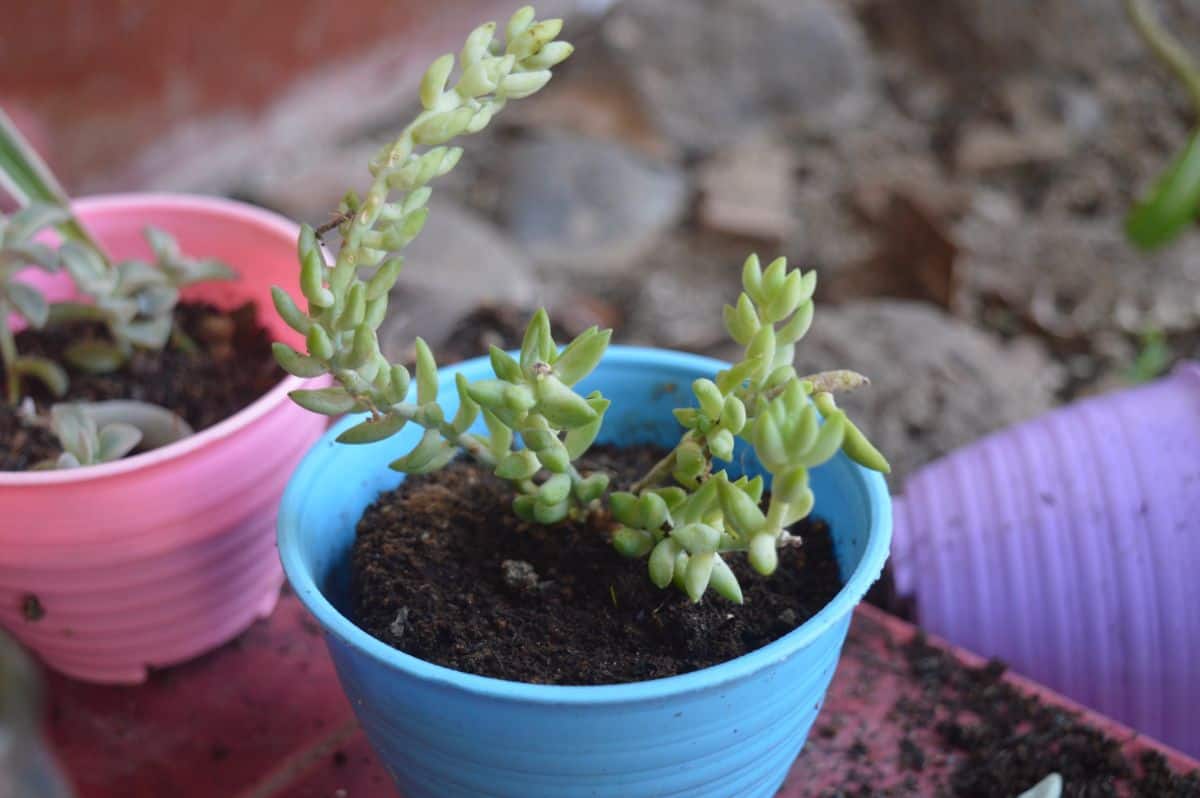
We still remember the day when we first saw donkey tail plants at our local garden center. They were these beady, string plants that indeed, look like tails. We were told that it will do well outdoors, but they can join our collection of indoor succulents as well.
A few years later, we now have an army of these sedum plants growing all around our garden. We managed to grow all of them from just the couple of mature plants we took home that day.
As it turns out, this unique and stunning plant is easy to care for and propagate. In this quick guide, we seek to pass all the information we’ve learned about it down to you.
Jump to:
- What Is Donkey’s Tail?
- Donkey Tail Succulent Care
- Lighting Requirements
- How Will I Know if My Donkey Tail Succulent Is Getting Too Much Sun?
- Watering Requirements
- Temperature
- Soil Requirements
- Pests
- Donkey Tail Succulent Propagation
- Leaf Propagation
- Stem Propagation
- How Long Does It Take for Donkey Tail To Propagate?
- More Tips To Propagate Donkey Tail Succulents Successfully
- 1. Place Your Cuttings in a Spot That Gets Indirect, Bright Sunlight
- 2. You Can Use a Rooting Hormone
- 3. Give Your New Plants Plenty of Nutrition
- 4. You Can Directly Plant Multiple Cuttings Into a Single Pot
- Growing More Donkey Tails for Your Garden
What Is Donkey’s Tail?
| Name: | Sedum morganianum |
| Soil: | Soil that drains well |
| Blooming: | Summer |
| Light: | Bright shade or partial sun |
| Water: | Once every month |
| Propagation: | Stem cuttings |
Donkey’s tail goes by many common names. Lamb’s tail, horses’ tail, tail plants, but burro’s tail remains the most popular term that people use, at least in our plant circle.
With the scientific name, Sedum morganianum, the donkey tail plant is a sedum with long stems surrounded by small and juicy leaves. People often place it in hanging planters, allowing its leafy stem to cascade down like a clump of lime green or blue-green tails.
We prefer to include these plants in our plant arrangements. Their dangling greenery can liven up any pot along with other succulents and cacti.
No products found.
If you’re thinking of doing the same thing, just remember to plant them with those that share their water and lighting requirements. You will get to ensure that all your plants will thrive this way.

Buy it from:
Donkey Tail Succulent Care
Since we are already talking about water and lighting requirements, here are the various factors that you should keep in mind when caring for a donkey tail succulent.
Lighting Requirements
The donkey’s tail is a plant that loves bright but indirect sunlight. While it does enjoy the brightness, its leaves will burn under the direct heat of the sun.
If you’re planning to grow it outdoors, pick a partially shaded part of your garden. Meanwhile, if you wish to care for it indoors, we recommend a sunny spot in your home, preferably somewhere that gets a lot of morning or afternoon sun.
How Will I Know if My Donkey Tail Succulent Is Getting Too Much Sun?
The effects will be quite noticeable on the color of its leaves. Getting its ideal lighting, this sedum plant’s leaves will come in rich green color. On the other hand, those that are getting too much sun exposure will have lackluster pale green leaves.

Watering Requirements
Did you know that all those juicy leaves contain water? Hence, donkey’s tail doesn’t really need a lot of watering. We water ours only once every 10 to 12 days.
Please note that this will highly depend on our current weather conditions. For instance, days tend to be longer and warmer during the summer so we may water more frequently. Meanwhile, we tend to don’t water as much during the rainy and colder months.
Here’s a good rule of thumb: Wait for your soil to be completely dry before watering. Then whenever you do water, make sure that your soil gets completely soaked.
Lastly, we have also noticed that plants in clay pots tend to dry out faster compared to those that reside in other types of planters.
Temperature
Donkey tails are known to be pretty hardy plants, but they don’t do well in freezing conditions. Ours can sustain a couple of days of frost, but they definitely start showing signs of stress after long periods of freezing temperatures.
The best way to protect them during the winter months is to bring them indoors. If that’s not an option, then you can put shade cloths over them outdoors instead.
Soil Requirements
Similar to other succulents, donkey’s tail grows best when planted in well-draining soil. We recommend adding a part of perlite to two parts of the cactus potting mix.
We have also tried using a sandy soil formula by mixing two parts of the same cactus soil with coarse sand. Both formulas have really worked well for us.
Pests
One of the benefits of growing donkey tail succulents is they don’t really invite a wide range of insects. The only pests we’ve ever seen in our plants are aphids that we simply hose off every month. If you do encounter this problem, then it’s not something that neem oil can’t fix.
Donkey Tail Succulent Propagation

Do you want more of these donkey tail plants in your garden? Then you’ll be pleased to learn that they are actually effortless to propagate. There are two main methods.
Leaf Propagation
The easiest way to grow plenty of baby plants is through leaf propagation. All you need are healthy leaf cuttings, tissue, and a few inches of soil. You can simply pluck healthy leaves from the plant to obtain your leaf cuttings.
We’ve also found success in rooting the green leaves that have fallen from our plant. This happens naturally as the donkey tail reaches its plant maturity.
We then let the individual leaves dry for a few days on a piece of tissue or kitchen paper. It can help absorb excess moisture, prevent rot, and heal leaf wounds faster.
Next, we will arrange the leaf cuttings on a tray of soil and wait for them to root. There are times when we’ll simply lay them on fresh soil, especially if we have vacant spots in our garden.
All that’s left is to wait for the roots to grow and establish, watering every few days or whenever the soil feels dry. Adjust your watering regimen as your baby plants continue to grow.
Transfer them to individual pots once they have already established a strong root system.
Stem Propagation
We don’t usually prefer this method due to its limited yield. However, there are times when stem propagation can come in handy.
You will notice your larger plants shedding more leaves at the slightest touch as they get older. This results in awkward bald spots on more mature stems.
Fortunately, this gives us a guilt-free opportunity to harvest stem cuttings. We do this by cutting the stems to our desired length using a clean and sharp pruning tool.
We then gently pluck away the bottom leaves, getting the healthy ones to propagate and discarding the rest. Again, we allow our cuttings to heal on a sheet of paper. Once the ends have callused over, we then plant these cutting directly into the soil.
Some growers wait for another couple of days before watering. It will help prevent further rotting in case the wounds haven’t really dried out completely.
We then start watering to help develop new root systems. We usually water our stem cuttings every five days, never letting the soil get too wet or too dry. This will still vary on current weather conditions, though.
In any case, just continue watering until you have new and healthy plants waiting to be re-potted.
How Long Does It Take for Donkey Tail To Propagate?
It will take a while for your cutting to establish new roots.
In our experience, we’ve found our leaf and stem cuttings to take anywhere around two to four weeks to establish a root system.

More Tips To Propagate Donkey Tail Succulents Successfully
To succeed in propagating donkey tail succulents, here are other tips that you need to keep in mind:
1. Place Your Cuttings in a Spot That Gets Indirect, Bright Sunlight
This is important because new cuttings are more susceptible to getting burnt under direct sunlight since they store less water than fully-grown plants.
2. You Can Use a Rooting Hormone
Excited growers can dip their healed cuttings in rooting hormone. This is really not necessary since you can certainly propagate your cuttings as they are.
However, this step significantly hastens the rooting process. We personally only do this when we’re performing our propagation experiments with kids.
3. Give Your New Plants Plenty of Nutrition
We usually top our newly re-potted baby plants with worm castings to give them an added health boost. Just like the rooting hormone, this step is optional as well.
4. You Can Directly Plant Multiple Cuttings Into a Single Pot
A single leafy donkey tail stem will look awkward in its own pot. Fortunately, you don’t have to wait for them to grow new stems. Instead, you can plant a cluster of your new baby plants together to create that fuller look.
Growing More Donkey Tails for Your Garden
It’s easy to see why donkey tails have become such popular plants in both online and offline plant communities. They are hardy plants that can thrive even under the hands of a neglectful plant lover.
A donkey tail succulent is very forgiving as a house plant while looking beautiful in your plant basket. If raised under ideal conditions, it can even grow plant blooms.
Donkey tail succulent flowers look like delicate pink rosettes at the tips of the long stems. Lastly, it is very easy to propagate. You can easily grow plenty of baby plants from just a single mother plant.
By keeping the tips we have shared with you in mind, you can get your new plant to root in no time. Good luck!

